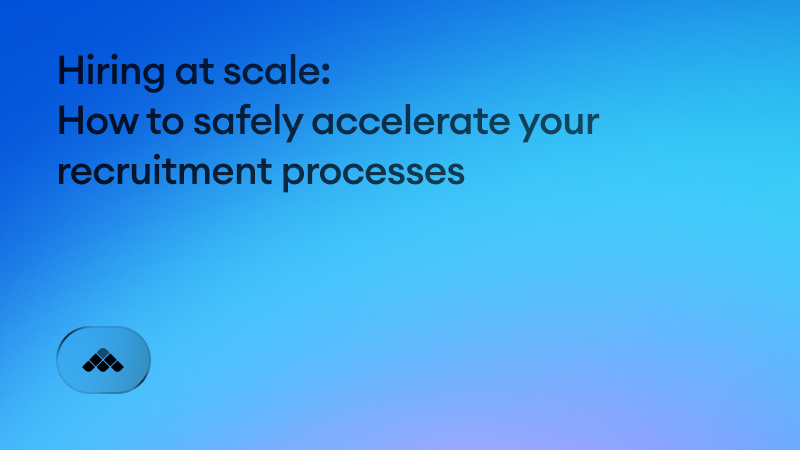Scaling an organization is exciting. Every team is full speed ahead creating new processes, signing more customers, and pushing the company to new heights.
But amidst the excitement, talent teams find themselves suddenly in the deep end. As headcount goals accelerate, there’s serious pressure to move faster, fill roles in bulk, and somehow still keep the bar for quality high.
For many recruiting leaders, it can feel like trying to rebuild an airplane mid-flight. Existing workflows start to crack under volume. Interviewers get stretched thin. Communication breaks down. And before long, the hiring process that once felt smooth starts showing serious strain.
The answer can’t just be to work harder. You need scalable systems that can handle higher volume without losing precision or candidate experience.
This article explores what hiring at scale really means, the challenges most teams face when they reach that inflection point, and how to build a process that can grow sustainably.
What is hiring at scale?
Hiring at scale means recruiting large numbers of employees within a short timeframe while maintaining speed, quality, and alignment. It happens when an organization needs to rapidly expand, whether due to funding, market growth, or strategic transformation.
It can mean hiring often across multiple departments, locations, and roles. It can also mean massively increasing one or two key positions: frontline sales, developers, or support staff. In fact, it often starts by scaling up the recruiting team itself.
Unlike one-off hiring, scaling requires repeatable, structured processes that allow dozens (or hundreds) of candidates to move through the pipeline efficiently. You need an engine that can continuously attract, assess, and onboard the right talent.
Scaling hiring also introduces new complexity: more stakeholders, more interviews, and more potential for misalignment. That’s why successful teams treat hiring at scale like a business system. They rely on automation, data, and clear ownership to keep everything moving smoothly.
When done right, it strengthens your organization’s ability to identify and hire top performers at speed, without sacrificing the qualities that make your company unique.
Key challenges of hiring at scale
When recruiting volume spikes, the entire system—from sourcing to interviewing—comes under stress. Below are some of the most common challenges of hiring at scale, and why they can hold growing organizations back.
1. Operational bottlenecks
Recruiting processes that worked fine at 10 hires a quarter tend to fall apart at 50. Manual tasks like scheduling interviews, logging feedback, and updating candidate data don’t scale efficiently.
The result? Slow hiring cycles, dropped candidates, and burned-out recruiters.
Without clear workflows or automation, talent teams struggle to keep up. Small inefficiencies compound quickly, and what used to be minor friction becomes a serious blocker to growth.
2. Misalignment between teams
At scale, recruiting is a true team sport. Misalignment between recruiters, hiring managers, and executives can derail even the best strategies. When goals, priorities, or definitions of a “good candidate” differ, interviews feel inconsistent and offers take too long.
This disconnect often stems from a lack of structured hiring criteria and centralized communication. The larger your hiring organization becomes, the more essential it is to define what “great” looks like, and ensure everyone evaluates candidates the same way.
3. Maintaining quality at speed
Speed is essential to scale. But rushing the process risks lowering the hiring bar. Without structure and rigor, interview quality can suffer. You get poor decisions, high attrition, and long-term cultural costs.
Scaling teams must find a balance: hire fast enough to meet growth targets, but not so fast that they compromise on standards.
Standardized rubrics, interviewer training, and interview intelligence tools (like Metaview) are critical to maintaining consistency and fairness at scale.
4. Cultural consistency
When hiring rapidly, company culture can easily become diluted. New hires join faster than values can be reinforced, and cultural norms that were once natural start to fade.
Over time, this can create silos and reduce team cohesion.
Maintaining culture during rapid growth requires intentional effort. That means clearly articulated values, structured culture fit interviews, and strong onboarding processes that connect new hires to your mission and expectations.
5. Candidate experience under pressure
A surge in hiring volume can easily overwhelm communication systems. Candidates might wait longer for feedback, experience disorganized interviews, or receive inconsistent messaging about the role.
Even small lapses can damage your employer brand.
At scale, maintaining a positive candidate experience depends on automation, transparency, and consistent follow-through. AI and workflow tools can help ensure that every candidate—successful or not—experiences a thoughtful and timely process.
6. Technology and data fragmentation
When different recruiting tools don’t integrate properly, teams lose visibility into what’s happening across the funnel. Data ends up siloed in ATS systems, calendars, emails, and spreadsheets, and it’s difficult to measure performance or forecast hiring needs.
A scalable hiring process requires an integrated tech stack. Every tool—from sourcing and assessment to analytics—should communicate seamlessly (and with no tech wizardry required).
This not only saves time but also enables smarter, data-driven decision-making.
How the right tools help overcome these challenges
Truthfully, the challenges of hiring at scale can only really be solved with smarter systems. The right recruiting tools can automate repetitive work, keep data flowing, and bring structure to every part of the process.
Whether you’re upgrading your ATS or HR platforms, or getting new sourcing systems or AI hiring tools, here are some of your chief priorities:
Automation to handle volume
Recruiting automation reduces the manual load on talent teams. From sourcing to interview scheduling, automation saves hours per week. And crucially, they help recruiters focus on relationship-building and decision-making, instead of admin.
Integrated platforms for visibility
When your ATS, sourcing tools, and analytics all connect, you gain real-time visibility into pipeline health. Integrated data lets teams spot bottlenecks early, forecast hiring needs accurately, and make decisions grounded in evidence, not guesswork.
Standardized interviewing for quality and fairness
Structured interviews and scorecards help maintain quality, even as hiring ramps up. Consistent evaluation criteria ensure that every candidate is assessed to the same standards, protecting both fairness and hiring bar.
Collaboration tools that keep teams aligned
Hiring at scale requires tight coordination between recruiters, hiring managers, and executives. Tools that centralize feedback, notes, and progress tracking prevent misalignment and speed up decision-making.
Analytics and insights for continuous improvement
Scalable recruiting depends on learning from data. Which you’ll have a whole lot more of, and much of it unstructured and hard to work with. Analytics tools surface trends like time-to-fill, offer acceptance rates, or interviewer bias from your entire information set.
This lets you iterate and refine your process, even as volume increases.
With the right infrastructure in place, hiring at scale goes from a mad scramble to a predictable, repeatable system.
How Metaview makes recruiting scalable
Metaview is an integrated suite of AI agents that multiply your hiring capacity without expanding headcount. By automating time-intensive tasks throughout your recruitment workflow, these tools transform bottlenecks into accelerators:
- Job creation and launch: The free Hiring Studio generates polished job descriptions in seconds, dramatically reducing time-to-market for new openings.
- Intelligent candidate sourcing: Feed the AI Sourcing agent job descriptions, interview notes, or briefs, and it surfaces qualified candidates from diverse channels. This eliminates the giant sourcing bottleneck that typically constrains recruiting velocity.
- Automated interview intelligence: The AI Notetaker documents every candidate conversation without human intervention, producing structured transcripts, summaries, and analysis that power faster, more informed decisions.
- Pipeline analytics and process optimization: AI Reports synthesize interview data into actionable insights about your hiring operations. They reveal telling patterns in interview quality, candidate pool strength, and compensation levels, all without manual analysis.
In short, you get everything you need to remove the biggest time-wasters, and put your energy toward high-value activities like candidate relationships and strategic planning.
Automation handles the operational burden, and your hiring function can scale smoothly as demand grows.
Build a scalable talent acquisition strategy
Hiring at scale is one of the biggest tests of an organization’s maturity. It demands coordination, structure, and systems that can flex as the company grows. Without the right foundation, speed and quality inevitably collide, leading to wasted effort, poor candidate experiences, and long-term hiring debt.
But it doesn’t have to be that way. With the right mix of automation, alignment, and analytics, your talent team can turn growth from a grind into the thrilling phase it ought to be.
In particular, tools like Metaview make it possible to handle scale intelligently. They remove bottlenecks, capture actionable data, and ensure every hiring decision reflects your highest standards.
Start scaling your hiring process the smart way. Try Metaview for free today.
FAQs about hiring at scale
1. How do I know when it’s time to upgrade my hiring process?
If your team is consistently behind on headcount goals, losing candidates due to delays, or struggling to maintain consistency across interviews, it’s time for change. The tipping point often comes when ad-hoc recruiting systems can’t handle the volume. This signals a need for automation and better-defined workflows.
2. What roles should I hire for first when scaling quickly?
Focus on hiring for leverage. Choose roles that help you sustain and accelerate future growth. That usually means engineering, sales, and recruiting operations early on. Building a strong recruiting foundation first ensures you can keep scaling efficiently without bottlenecks later.
3. How can small teams prepare for large-scale hiring?
Even before volume increases, small teams can build scalable systems by documenting processes, using structured interviews, and adopting automation tools early. Establishing these habits in advance makes scaling smoother when growth accelerates.
4. What’s the biggest mistake companies make when hiring at scale?
The most common mistake is sacrificing structure for speed. When interview quality, rubrics, or alignment slip, you risk poor hiring decisions that slow you down in the long run. The most successful scaling teams invest early in processes and tools that maintain consistency as they grow.
5. How does technology help maintain culture while scaling?
Culture can easily get diluted when hiring quickly. Technology helps by keeping hiring criteria consistent, surfacing interviewer behaviors, and ensuring every new hire aligns with your company’s values. AI tools like Metaview also provide visibility into what great interviews look like, helping teams preserve cultural integrity while scaling fast.


